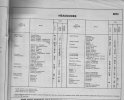Very interesting document has been added to Timetable World - the 1962 CWN for Victoria, see here:

timetableworld.com
Fascinating insight into the "prewar EMU" era.
The service pattern has been partly mentioned above, but not all the branches so the complete pattern appears to be as follows. Stopping patterns are from the following year - 1963 - timetable on Timetable World so might not reflect 1962 but "probably" do.
xx00 Brighton non-stop; Brighton Belle every 4 hours (which meant some interesting stock movements to accommodate this, as theoretically only 3 diagrams were required for an hourly service)
xx06 Bognor via Gatwick, semi-fast to Gatwick then all stations. Portion detached at Gatwick
xx09 Oxted line service, seemed to be, from what I can make out, Tunbridge Wells West via East Grinstead
xx18 Bognor fast via Dorking, one or two gaps (e.g. no 1318)
xx21 Gatwick (East Croydon and Redhill) (daily in 1962, but seemed to be FO in 1963)
xx25 Littlehampton via Worthing, but not all hours
xx28 Brighton semi-fast (Clapham, East Croydon, Redhill, Haywards Heath, Preston Park)
xx36 Bognor via Gatwick, as xx06
xx45 Eastbourne and Ore, but not all hours
xx47 Brighton stopper, Clapham, East Croydon, Purley then all
xx51 Gatwick, as per xx21
Some interesting things here; firstly, even in 1962 you can see the forerunner of the Gatwick Express with a 15-min interval clockface semi-fast service. (In fact it's very similar to the early-80s "Rapid City Link" which also detached portions at Gatwick).
Interesting also that the Littlehampton and Ore fasts do not run every hour, with some gaps in the middle of the day on Mon-Fri (Sats had more services).
In terms of stock, the Brighton fast, Littlehampton and Ores were generally run with PULs and PANs, sometimes in multiple with CORs - except the Brighton Belle run with 10BEL. Some interworking between Ores and Brighton fasts occurred (e.g. 0925 and 1025 up fasts from Brighton formed 1045 and 1145 to Ore).
The Bognor fasts at xx18 were COR/BUF/COR combos in the main and conveyed a Portsmouth Harbour portion (4COR), in that respect they were similar to their early 80s equivalent.
The Bognors and the Gatwick terminators were BILs, with the Bognors detaching a 2HAL at Gatwick.
The Brighton semi-fasts and stoppers were generally a mixture of LAVs and BILs, and generally interworked at Victoria, with some exceptions. One service (the 1128 semi-fast) seemed to convey a 4SUB. Interesting to note that the Brighton semi-fast of 1962 used "stopping service" stock in the main, in contrast to the later use of CIGs and BIGs, identical to the fasts.
There were some summer-only workings which incorporated CEPs, e.g. the 1032 to Eastbourne, and the 1113 Brighton (CEP/EPB/CEP - with the EPB in the middle). "Loans" from the South Eastern in between the peaks?
Finally the xx09 Oxted service seemed to be a mixture of DEMUs and (presumably) steam, with the inbound and outbound stock not always matching each hour, leading to some interesting stock movements.


